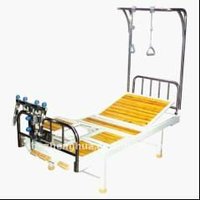Joseph H. Pilates, born in the late 1800's, is often considered the father of modern Physical Therapy. Much of his early work was done in a hospital after World War 1 where he was able, albeit crudely, to help many patients get strong enough to leave their beds. Its said that Joe Pilates got the wounded up and out of their beds faster than the doctors. Pilates' secret weapon was strength training. He fashioned crude weight training devices out of bed springs and surgical tubing. He rigged up pulleys and springs against the traction beds that became home to many of the wounded soldiers after The War. With little more than shear determination Joe Pilates, a high school dropout who happened to be working as a hospital orderly, was able to develop many of the Physical Therapy techniques that are used today in the modern PT clinic.
 |
| Modern Traction Bed |
Some say Joe Pilates was a Nurse or a PT but actually he was just a simple man who believed in nature's ability to heal. He instinctively knew that "movement heals" and would not stop working with a patient until he was strong enough and fit enough to get out of bed. One of Joe's early inventions, he called the Bednasium, was a traction bed type of device that would allow even a bedridden person to exercise and get/stay fit and strong.
 |
| Joe Pilates working with a client on the Bednasium |
This Bednasium matured into the modern Pilates Cadillac which resembles a four poster bed. The exercises done on these types of modern Pilates equipment run the gamut from super simple and therapeutic - such as would have to be done with patients with limited strength or mobility - to the super advanced extreme exercises that would make even Olympic gymnasts break a sweat!
 |
| The Pilates Cadillac |
And so it is that Pilates, as an exercise method, has evolved from a therapeutic beginning (Joe Pilates himself began exercising to heal himself from childhood Asthma and Rickets) to an exercise discipline sought out by celebrities and everyday folks looking to get fit and stay in shape and yet more recently has turned towards healing people again.
 |
| The original Pilates Studio in NYC from left:Joe, Mary (Joe's niece), Clara, unknown client |
But when we ask the question, Which is best....Physical Therapy or Pilates? It seems that for the injured patient, PT always wins out. So how come the shift away from Pilates, a proven method of getting patients well enough to leave the hospital in a timely fashion. In my opinion, it is not so much a shift of what the actual activity is, but more a shift of who performs it. After the war Joseph Pilates came to America and opened a Gym (we now call it a Pilates Studio) in the heart of the entertainment district in New York City and although he rehabbed many a dancer in his time there, his exercise techniques became better known as more of a fitness/dance method and less of a rehab method. Then, after Joe's death in 1967, the method stayed with the dancers and fitness enthusiasts for many years until the last 5-10 years when it has emerged again as a "back to basics" method of rehabilitating everything from joint replacements to aching backs and even neurological issues. So in recent years Pilates has primarily been taught by dancers and fitness instructors to people who want to get and stay fit. Now that many Physical Therapists are realizing the benefits from Pilates, perhaps by taking a class at their local gym themselves, it is beginning to be accepted as a proven method of physical therapy. Courses of study specifically for PT's are popping up across the country including the PIA courses
"Pilates Essentials", "Mat 1" and
"Reformer 1" that are pre-approved for
CE credits for PT's and PTA's. The best way to rehabilitate an injury, recent surgery or bio mechanical issue is to learn corrective body mechanics, to strengthen weaker body parts and stretch the tighter body parts, thereby restoring the balance that our bodies most definitely crave. Of course, Joesph Pilates knew we needed this basic movement experince almost 100 years ago. Pilates is not a new craze or a fad - it is proven to make people well. It heals the body from the inside out and not only addresses a particular body part that requires rehabilitation, but it actually addresses the entire body as a whole and makes the whole body strong, fit and limber so that aches and pains become a thing of the past.






So......It is not really a question of which is best, PT or Pilates, but rather which Therapy Center should I go to to get the best therapy? Because if it was up to me, I would choose the therapy center where the therapists are trained in Pilates techniques and employ them right alongside the more traditional therapy methods. This way I can be sure my therapeutic outcome would be the absolute best. Who knows, I might even keep doing Pilates every day because it makes me feel good and I know it will help prevent future injuries (see Frankie's PIA Pilates Blog on
"Pilates for Life").






